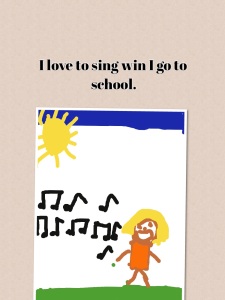“Grown-ups love figures… When you tell them you’ve made a new friend they never ask you any questions about essential matters. They never say to you “What does his voice sound like? What games does he love best? Does he collect butterflies? ” Instead they demand “How old is he? How much does he weigh? How much money does his father make? ” Only from these figures do they think they have learned anything about him.” -Antoine de Saint-Exupéry, The Little Prince
 Grown ups do love their figures…it’s all about data. We have to quantify something, measure it, analyze it and dissect it down to its very bones before we decide if something has meaning or value. A recent article in our local newspaper ran in giant bold type the front page headline that the use of iPads in our district is not resulting in significant gains in scores. If you are looking to sensationalize a hot-button topic, then the more negative the headline, the better.
Grown ups do love their figures…it’s all about data. We have to quantify something, measure it, analyze it and dissect it down to its very bones before we decide if something has meaning or value. A recent article in our local newspaper ran in giant bold type the front page headline that the use of iPads in our district is not resulting in significant gains in scores. If you are looking to sensationalize a hot-button topic, then the more negative the headline, the better.
The funny thing about data is that it doesn’t take into account many important factors. Factors that can’t always be measured. We have had our iPads for 3 years. Some would say that’s enough time to show some major growth. This would be true if iPads manufactured intelligence and poured it into the mouths of our students. iPads are not a magic bullet or get smart quick scheme. They are not integrated equally into every classroom, nor are they used in a cookie-cutter way in every lesson for every student. Some teachers use them extensively for in-depth learning, and others…well, not so much. Meaningful staff development is critical and my district has done a good job of working with teachers in best practices.
But what about each individual child? Since the iPad is merely a tool, it must be used in a way that enhances individual student learning. Information is an essential key to learning. Accessing information is a logical need. How does a class of 30 plus students access information equitably in a classroom with 2 desktop computers (if that)? We don’t use card catalogs, hard bound encyclopedias, or phone books any more. We rarely use paper maps (which is just as well, I can’t ever fold them correctly). With the fading away of these sources of information, where are we to get information?
Wholesale dismissal of the use of iPads after 3 short years of implementation is short-sighted. They provide necessary accommodations for disabled students, that have never before been available. Vision impaired, speech impaired and autistic children have an open avenue of accessibility that is not just necessary, it’s their right. Students who have learning disabilities or have learning delays can have learning experiences that are “just in time” for them. Similarly, students who excel and are more advanced than their peers have the ability to work at that higher level with the iPad. It is because of these abilities to personalize learning for my students that 100% of my students have gone to first grade reading above grade level for the past 3 years, that my school has earned the Apple Distinguished School award 2 years in a row, and earned an overall rating of excellent, scoring 99.3% on the Federal Report Card. Our school rating went up to 5th in the school district from 8th in the 2011-12 school year.
Where is that headline? That never made the newspaper.
My students learning experiences are richer, more in-depth and more rigorous because each of them have access to a powerful learning tool. I can’t imagine teaching without them now. Think of the many ways you access information today. My guess is, you do it automatically without thinking of the technology necessary. How inconvenient would it be if you lost access to that technology? How backward would it be to say, “I’m sorry, you aren’t making statistically significant progress in your work life so we are going to remove your access to information.” ? Heck, if my SmartBoard goes down for a day or I don’t have internet access at school for a few hours I feel handicapped.
This is the world we live in and it will only become more wrapped up in the need for technological access. Dissect that data all you want…but behind every number is a child. Are you going to look at that child and say, “Sorry, but you aren’t worth the expense to adequately educate you for the future.”? I know I can’t say it. I’m grateful I work in a place that can’t say it either .
Today we will do exciting new things. Let’s get to it.
Hi Kristi, I loved your response to the newspaper article! I teach kindergarten and have five I PADS in my classroom. Your blog has given me so many ideas on how to use them effectively in my K classroom. I recently had a child break her arm (writing arm) and she was able to take part in many of the class lessons by using the I PAD it helped us modify. It also helped me think about other ways I could use them in the classroom. Thanks for your many great ideas! Melissa
Melissa
Thank you! I’m glad my blog has been helpful. It irritates me when negative press is given to something that people know nothing about first hand. Keep up the great work!
Great rebuttal! You go girl!
Thank you!